The Eatery, the largest dining facility on the University of Pittsburgh campus, needed a major overhaul to attract a higher volume of today’s food-savvy guests.
The project was also an opportunity to rethink what a traditional dining hall could be, reimagining it as a dynamic community hub that can support meaningful experiences. The Eatery is part of Pitt Eats, the university’s dining program, and was last renovated in 2007.
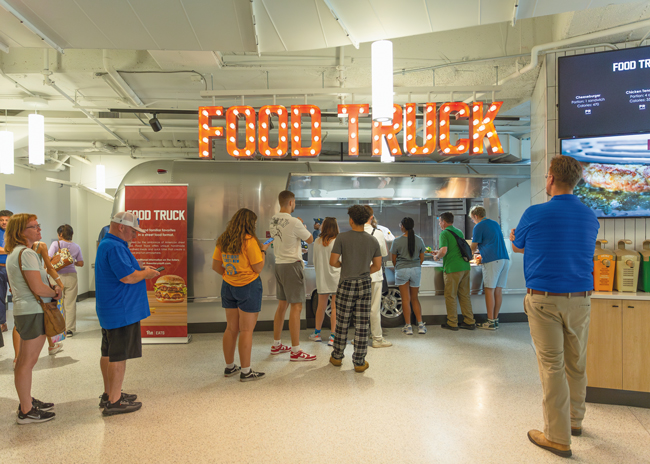 Photos by Mackenzie RandallRunning from April 2023 through completion in August 2024, this eight-phase, $28 million, 52,000-square-foot renovation project transformed The Eatery into a social and community food hall with myriad residential and retail restaurant operations.
Photos by Mackenzie RandallRunning from April 2023 through completion in August 2024, this eight-phase, $28 million, 52,000-square-foot renovation project transformed The Eatery into a social and community food hall with myriad residential and retail restaurant operations.
“This is the main dining facility for first-year students and is the highest-volume facility on campus,” says Steve Schurr, resident district manager for this project with Chartwells Higher Education, the contract management supplier for Pitt Eats. “We knew we couldn’t do this in one summer or winter break. We had a temporary service plan and offered all regular menu options without compromising guest satisfaction.”
To help make it easier for guests to navigate the foodservice operation during the renovation, a comprehensive and dynamic physical wayfinding strategy was necessary. The design team collaborated with the university to develop a colorful approach to wall and column graphics to direct students to the various venues in the circuitous space. In addition, the university provided project updates via a dedicated website as well as weekly emails and social media posts.
An all-you-care-to-eat facility, The Eatery now features 11 distinct concepts. “By bringing together talented chefs from diverse culinary backgrounds, we’ve developed menus tailored to create each station’s unique experience,” Schurr says. “Despite the variety of cuisines, there’s a seamless and inclusive atmosphere as guests move from one station to the next.”
The overall design language establishes a cohesive environment while incorporating a variety of distinct identities and microenvironments for the food concepts. “Drawing on DesignAgency’s expertise in hospitality design, we developed a welcoming, functional and flexible environment that serves as a true community hub for students, faculty and area residents,” says Alexandra Bruemmer Cole, managing director and principal, DesignAgency, Washington, DC.
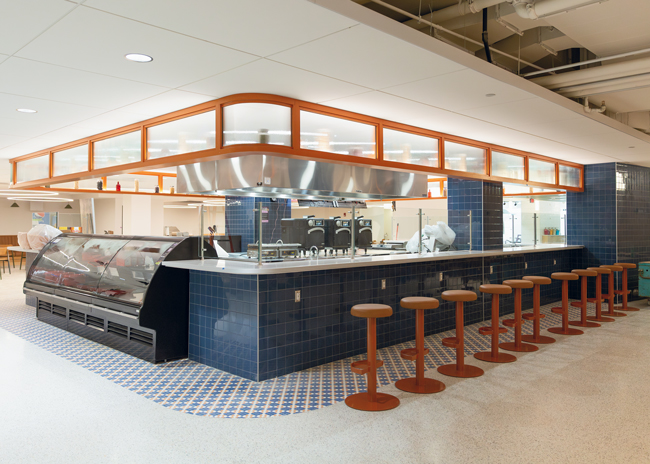 Guests can sit on high-top stools at the Briny Pickle counter to watch the culinary team make the menu items. A deli case also offers pasta and cucumber salads and sandwiches.Along the way, the project faced some daunting challenges. Litchfield Towers and residence hall was originally built in 1964, and the dining hall was “showing its age,” Bruemmer Cole says. “It is located on the lower level and features low ceilings and few windows, and traffic has to flow around three large building cores supporting the towers above.”
Guests can sit on high-top stools at the Briny Pickle counter to watch the culinary team make the menu items. A deli case also offers pasta and cucumber salads and sandwiches.Along the way, the project faced some daunting challenges. Litchfield Towers and residence hall was originally built in 1964, and the dining hall was “showing its age,” Bruemmer Cole says. “It is located on the lower level and features low ceilings and few windows, and traffic has to flow around three large building cores supporting the towers above.”
“The design team decided to use two of these as unifying elements in the plan, with similar neutral treatment and banquette seating around,” adds Jessica Abell, senior project manager, Next Step Design, Annapolis, Md. “The large ceiling beams and columns created low head heights and cramped spaces. Thoughtful lighting and choice of color helped to lighten the space and provide the sense of openness when there was none.”
“Colorful tiles, distinct paneling and lighting, neon signage and hanging planters shape each space and change the vibe while still working as a whole,” Bruemmer Cole adds. “The effect is less like a student dining hall and more like a collection of restaurants, markets and pop-ups. There’s even an Airstream food truck.”
To improve the arrival experience and carve out more space for additional food concepts, the floor plan was renovated to add an additional ground-floor entrance off Forbes Avenue, Pittsburgh’s busiest street, which happens to run through the heart of campus. The entrance enhances the dining hall’s visibility to passersby on foot and opens the interior to natural light, creating a brighter, more inviting atmosphere.
The space can be reconfigured to support dining and create casual study spaces. It can also be repositioned for a variety of other community-related activities such as karaoke and even food pop-ups.
“The result is a dynamic dining hall that supports connection, inclusivity and a sense of belonging,” Bruemmer Cole says.
Floor Plan
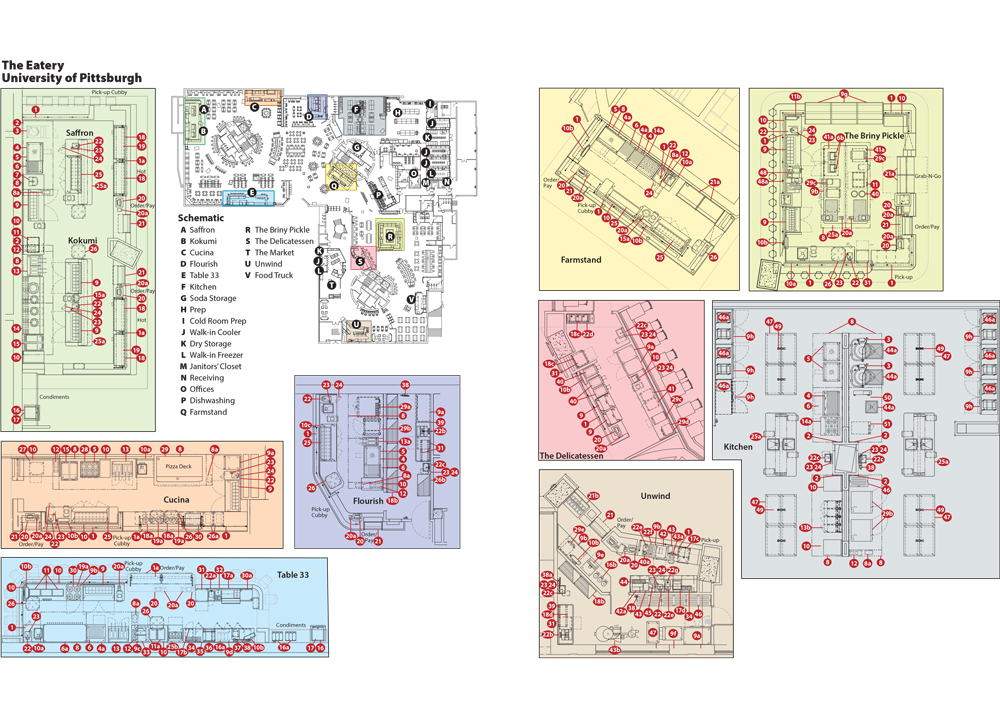
Floor Plan Equipment Key
Back-of-the-House Production
“While the front of house had been renovated multiple times over the years, the main kitchen was almost exactly as it was when it was built in the 1960s,” Abell says. “While not a part of the original scope, it was determined that a major overhaul of the kitchen would be necessary to service the new venues adequately. We worked directly with The Eatery’s executive chef and staff to plan out the flow of traffic, deliveries and waste management in an efficient way while updating to meet modern food service standards.”
The kitchen design includes rear-facing access for deliveries and front-facing doors for kitchen staff. From the loading dock, team members transport deliveries via a receiving hallway into a large dry-storage area, a walk-in freezer and three walk-in coolers, including one for proteins, one for vegetables and another for ready-to-eat foods. Each cooler and dry storage location contains doors on the loading dock side and the kitchen side for easy loading without disrupting the flow of the kitchen.
The expansive prep kitchen supports the individual front-of-the-house restaurants. One part of the prep kitchen maintains a cold temperature and connects to one of the walk-in coolers. “For vegetables, we clean them and then cut them using a machine that slices and dices,” says Caitlin Courtney, director of culinary with Chartwells Higher Ed. The team places the prepped vegetables into the walk-in cooler to stay fresh until needed for further production. In addition to prep tables and sinks,
the prep kitchen contains an ice machine, two large mixers and roll-in refrigerators.
The culinary team also makes its own pasta. “We have determined that we can produce a higher-quality pasta and reduce allergens,” Courtney says. The team prepares hot food on cooking lines. For example, one cookline has a tilting skillet for braising and slow-cooking stews and two kettles for soups, sauces and ramen broth. The team uses two combi ovens for preparing proteins, vegetables and pastas. Another cookline contains griddles and charbroilers for grilling proteins, a four-burner range for making sauces and fryers for cooking appetizers such as spring rolls, dumplings and chicken tenders. The team also uses a convection oven for roasting chicken, steak and vegetables, as well as bakery items.
Two blast chillers keep menu items such as grains cool until they are needed for service. “We also place leftovers in the blast chillers and send the leftovers to local food banks.
A designated space in the kitchen also allows the team to prepare bakery items, including cupcakes, cakes, cookies, croissants and Danishes for the entire campus. Though the team doesn’t make bread, it does make focaccia for the deli case.
A central beverage room feeds to multiple beverage dispensers located throughout The Eatery.
“In addition to preparing food for the front-of-the-house restaurants, we’re also preparing food for catering all over campus,” Courtney says.
Also in the back of the house, a dishwashing area sits a short distance from the main entrance to The Eatery. It contains a flight-type dishmachine that connects to a tray conveyor system onto which dining guests place their dirty dishes. Staff also use a separate room for pot washing.
 The Farmstand features made- to-order, plant- forward grain bowls with fresh-grilled proteins.
The Farmstand features made- to-order, plant- forward grain bowls with fresh-grilled proteins.
Front of the House
“The Chartwells team uses a menu planning program to determine the menu,” Courtney says. “We continuously test menu items and make adjustments to decide what works and what doesn’t. The most important aspect of being able to offer so much menu variety is organization and communication among the team members in the front and back of the house.”
Dining guests can order menu items from each restaurant. The operation also contains kiosk ordering for specific customized, made-to-order items at five stations: Farmstand (omelets during breakfast), Cucina (pasta), Flourish (sandwiches and salads), Food Truck (burgers and halal chicken tenders) and The Briny Pickle (sandwiches).
The Chartwells team also continuously receives feedback from students who use an e-mail feedback form, a text system and kiosks that allow students to rate their experiences with a variety of smiley faces. “Technology has helped us communicate with guests quickly and give them the best experience we can,” Courtney says. “This is their kitchen and living room. They should be able to relax, hang out with friends and have a positive culinary experience.”
 An industrial design contributes to the fun seating environment.
An industrial design contributes to the fun seating environment.
When guests enter The Eatery, they first see Farmstand featuring freshly made-to-order, plant-forward salads with fresh-grilled proteins such as chicken, steak, salmon, seafood, beans and tofu cooked on a countertop griddle and countertop charbroiler. One of the more popular menu items at this station are grain bowls containing grains, seasonal vegetables, house-made dressings and crunchy toppings. For breakfast, the team prepares made-to-order omelets. An adjacent beverage and breakfast station offers coffee, teas, waffles, cereal, desserts and snacks.
Kokumi is a Japanese word literally meaning “rich taste,” and in this instance, it’s one of the more popular stations at The Eatery. This build-your-own, customizable concept contains ingredients such as vegetables and proteins displayed in wells for guests to select. The culinary team uses five woks and a pasta cooker to prepare stir-fry noodles and fried rice and pepper steak as well as many other intensely flavored pan-Asian menu items.
Next to Kokumi, Saffron features North African, Middle Eastern, Indian and Silk Road-inspired menu items including vegan and vegetarian options, as well as halal-certified proteins. Named in partnership with a Muslim student group, the restaurant contains refrigerated rails to hold ingredients and a countertop griddle, countertop charbroiler and vertical broiler for cooking proteins for gyros and other menu items.
At Cucina, guests watch the culinary team in action. Staff here use a countertop griddle to cook guests’ selection of pasta, proteins and vegetables before topping these items with a variety of sauces. The Italian-inspired station also features culinary staff hand-stretching pizza dough before topping it with proteins and sauce and cooking it in a deck oven. The team also cooks rotating entrees such as chicken parmesan and garlic knots in the oven.
“Students and other guests love watching the action as their pasta and pizza are prepared as they watch,” Schurr says.
Guests attracted to rustic cuisine from 33 states in Latin America find their way to Table 33, also a build-your-own, customizable concept. “The cuisine here centers on the churrasco grill that allows us to offer flame-infused menu items,” Courtney says. The station also contains a tortilla press, countertop charbroiler and fryers. Popular menu items here include fried chips, tacos and rotating types of burritos. Guests here can also help themselves to beverages such as fresh-pressed orange juice.
“We change the menu every day and offer teaching kitchen classes with students once a month,” Courtney says. “Sometimes we work with different groups such as the Latinx Student Association and Asian Student Alliance.”
 At Kokumi, the culinary team uses five woks to prepare stir-fry noodles and fried rice and pepper steak as well as many other intensely flavored pan-Asian menu items.
At Kokumi, the culinary team uses five woks to prepare stir-fry noodles and fried rice and pepper steak as well as many other intensely flavored pan-Asian menu items.
At Flourish, guests find an allergen-friendly offering featuring a rotating menu of items free of nine common allergens (milk, egg, peanut, soy, wheat, tree nuts, shellfish, fish and sesame). “All the equipment, including the undercounter dishwasher, is separate from that at other restaurants and the kitchen so we make sure there is no cross contamination,” Schurr says. Equipment includes a convection oven, combi oven, countertop griddle and countertop charbroiler, as well as a refrigerator and freezer. The restaurant also contains a toaster and cold rails holding ingredients for salads, sandwiches and yogurt.
The Briny Pickle features deli-style foods, including made-to-order grilled cheese and other sandwiches such as house-made focaccia with turkey, salads, soups, vegetable platters and house-fried chips. “This provides a familiar deli counter experience and recognizing Pittsburghers’ love of pickles,” Schurr says. Guests can sit on high-top stools at the counter to watch the culinary team make the menu items. A deli case also offers pasta and cucumber salads and sandwiches.
Nearby, The Delicatessen offers dedicated Kosher meals in partnership with a local company, Elegant Edge Catering. The menu features lox, bagels, Turkish bourekas and hummus bowls.
Beverage lovers find their way to Unwind that displays a semiautomatic coffee roaster that can be seen through the large windows. Guests can order coffee drinks, teas, other beverages, pastries and gelato. Unwind encourages guests to come here not only to order menu items but also to relax and recharge.
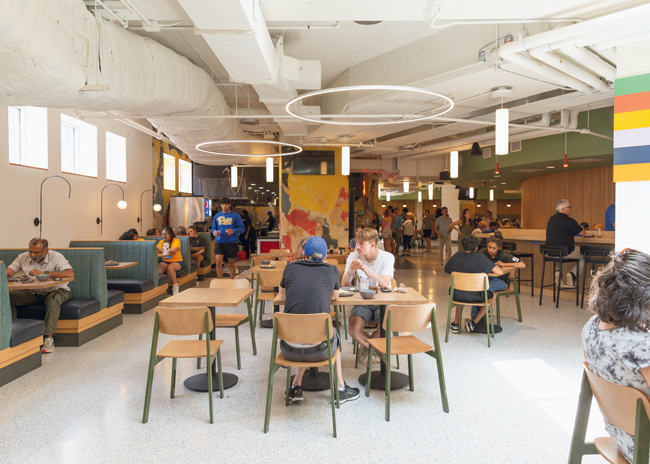 Lighting contributes to a feeling of a grand space.
Lighting contributes to a feeling of a grand space.
Other beverage stations spread throughout The Eatery offer waters, milk, nondairy beverages and carbonated drinks.
The Food Truck contains a charbroiler, flattop griddle and fryer for the culinary staff to cook American comfort food such as corn dogs, french fries, onion rings, halal-certified beef hamburgers, mashed potatoes and chicken tenders. Different menu themes are offered each week, such as Pittsburgh perogies and mac and cheese. The space also contains a dual soft-serve and milkshake machine.
“A big challenge was bringing an actual Airstream trailer into the existing building for this venue,” says Lisa Carver, principal, PWWG. “We researched and collaborated directly with the vendor to create a functional foodservice space within the trailer while also providing code-compliant access from the customer side.”
Another area in Litchfield Towers, Market at Towers, offers a contactless convenience store stocked with quick to-go food options. The market stays open 24 hours.
During the process of building and developing The Eatery, the design team learned many lessons. “Communication is key,” Courtney says. “So is setting a timeline and maintaining a flexible approach to menu development in order to balance menu variety with student favorites and service. We always have to adapt to customer feedback.”
For the future, the university and Chartwells team will continue to build on their success, expand events and offer additional training and development for the culinary team.
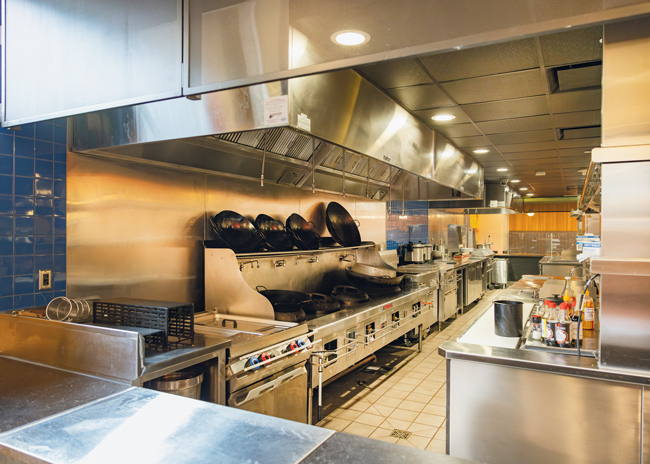 The full line of kitchen equipment supports production at most of the restaurants.
The full line of kitchen equipment supports production at most of the restaurants.
About the Project
- Opened: August 2024
- Scope of project: Complete renovation and new build of front and back of the house
- Website: theeateryatpitt.com
- Size: 52,000 sq. ft.
- Seats: 900 scattered throughout venue
- Daily transactions/covers: 7,500
- Hours: 7 a.m. to 11 p.m., Monday through Thursday; 7 a.m. to 10 p.m., Friday;
9 a.m. to 10 p.m., Saturday and Sunday; retail units outside the servery:
The Delicatessen, 10:30 a.m. to 7 p.m., Monday through Thursday; 10:30 a.m. to 3 p.m., Fridays; Amazon, 24/7; Unwind, 7 a.m. to 10 p.m. - Average check, door rates: Breakfast, $10.50; lunch, $14; dinner, $15.50
- Menu concepts:
- Farmstand: Made-to-order, plant-forward salads with grilled proteins.
- Kokumi: Intensely flavored pan-Asian menu items inspired by the cuisines of China, Japan and Thailand. Build-your-own, customizable.
- Saffron: North African, Middle Eastern and Indian menu items featuring
halal-certified proteins. - Cucina: Italian-inspired, handmade pasta, hand-stretched pizzas and rotating entrees.
- Table 33: Cuisine from the 33 states in Latin America including fresh-pressed tortillas and fresh-fried chips. Build-your-own, customizable.
- Flourish: Allergen-friendly station featuring a rotating menu of items free of nine common allergens (milk, egg, peanut, soy, wheat, tree nuts, shellfish, fish and sesame).
- The Briny Pickle: Deli-style foods, including sandwiches, salads and soups;
pickles and house-fried chips. - The Delicatessen: Dedicated Kosher meals; local partnership with Elegant Edge Catering; features bagels, matzo ball soup, pastrami sandwiches and chicken shawarma.
- Unwind: coffee (including house-roasted coffee blends), teas, other beverages, breakfast sandwiches, pastries and gelato.
- Food Truck: A street food format with American comfort food.
- Market at Towers: Frictionless convenience store stocked with quick to-go food options. Open 24 hours.
- Staff: 150 team members (125 are union), including executive chef and managers, some students
- Total project cost: $28 million
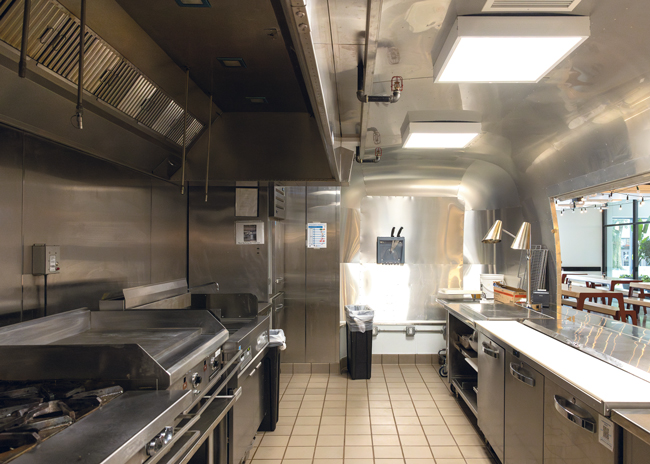 Food Truck contains a charbroiler, flattop griddle and fryer as well as a dual soft-serve and milkshake machine.
Food Truck contains a charbroiler, flattop griddle and fryer as well as a dual soft-serve and milkshake machine.
Key Players
- Owner: The University of Pittsburgh
- Vice chancellor for business services: Matthew Sterne
- Assistant vice chancellor for auxiliary services: Julie Bannister
- Director of dining services: Rose Basso
- Contract foodservice management for Pitt Eats: Chartwells Higher Education
- On-site resident district manager for this project: Steve Schurr
- Vice president of operations, Pitt Eats: John Longo
- Director of operations: Javohah Sinclair
- Director of culinary: Caitlin Courtney
- Senior marketing director: Maggie Weaver
- Architect: PWWG Architects, Pittsburgh: Lisa Carver, principal
- Interior design: Chartwells Higher Education and DesignAgency, Washington, DC: Alexandra Bruemmer Cole, managing director and principal
- Foodservice consultant: Next Step Design, Annapolis, Md.: Jessica Abell, senior project manager; Linda Callahan, studio director
- Equipment dealer: TriMark Marlinn, Cleveland
- Construction: Rycon Construction Inc., Cleveland



